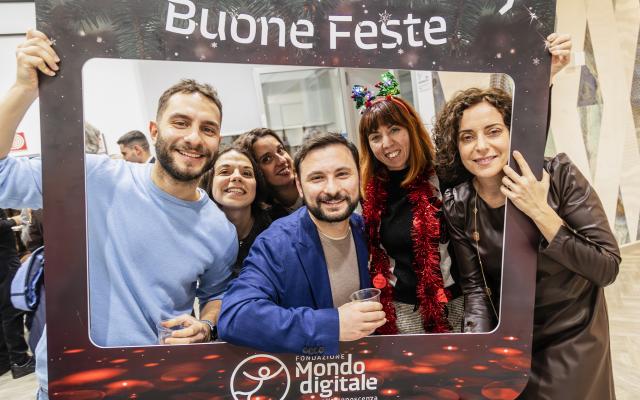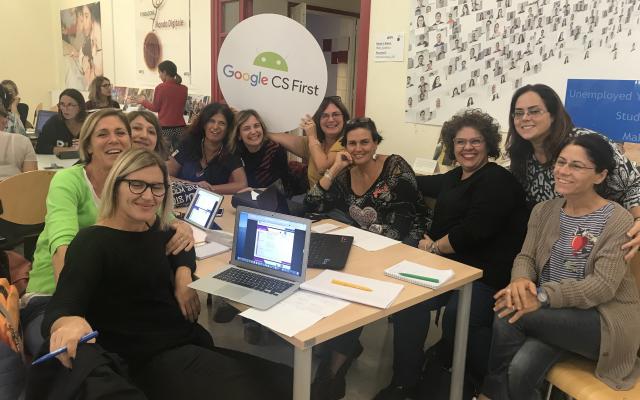A digital coach reports on the inclusive use of the CS First Platform
At the beginning of the new year, an article by Carlo Ernesto Galli Della Loggia rekindled the debate on the inclusive model of Italian schools. The Corriere della Sera editorialist believes it is a form of false inclusion in a kingdom of lies: “Italian classrooms, a unique case in the world, bring together disabled children, even severely disabled ones, with special educational needs students and an increasing number of foreign kids who cannot speak a word of Italian.”
Notwithstanding subsequent clarifications to underline the complexity of the issue, the debate raged immediately. A few weeks later, a bill to establish inclusive teaching in schools in schools of all levels was presented. An overview of the debate is provided by this in-depth analysis edited by Sara De Carli for Vita magazine.
At the Fondazione Mondo Digitale, we have always based ourselves on the ideas of Professor emeritus Tullio De Mauro who believed that the highest quality of education goes hand in hand with maximum inclusion, with the ability to take care of everyone without leaving anyone behind [also see: Buona la scuola se eccelle chi insegna, Internazionale, 2016]. The issue in Italian schools is described well and objectively by lSTATT Report on the scholastic inclusion of pupils with disabilities, which we recommend as interesting reading. Suffice it to say that 1 out of every 3 teachers still lack specific training and 12% are assigned late, while pupils with special needs and/or disabilities are on the increase. According to the latest data from the Ministry of Education and Merit, non-Italian students are also increasing and now account for ca. 10 percent of the school population.
We believe that the new generations should always be guaranteed the maximum educational opportunities. This is why we like to promote any tool that can facilitate and enhance teaching activities, like the CS First Platform that was developed by Google for schools. And we are pleased to share the results achieved by teachers – without hiding the issues – with our entire community.
Today, Onelia Onorati shares with us the experience of Emanuela Rinaldi, a Professor of Mathematics and Digital Coordinator at the Giovanni XXIII Comprehensive Institute of Villa San Giovanni in the Province of Reggio Calabria, who participated in the “Pictures at an Exhibition” digital room held by Barbara Avella and Mauro Crepaldi [see news: Didactic Projects with CS First]. These are meetings are meant for teachers, who have already followed CS First training sessions, to learn more about the platform and the tools for developing educational projects, including curriculum mapping. The "digital room" format allows teachers, educators, and coaches to informally share useful information, experiences, and good practices. “Initially, I found the initiative quite complex, but then I grew very involved. It was nice to join the debate and escape the logic of a one-way frontal lesson," explains Prof. Emanuela.
So, how did the school discover CS First? “When the Fondazione Mondo Digitale contacted me, like other organisations that collaborate with schools, a bell went off in my head when I heard the expression innovative tool for teaching,” explains the professor. “Given my predisposition to inform myself about innovative proposals, I accepted the initiative and submitted it to School Director Luisa Antonella Ottanà, who authorized me to provide the information to all teachers. I immediately realized that it was an interesting coding solution in line with STEM disciplines.”
Students access the platform with dedicated credentials which, however, are not linked to personal accounts. And they don't need to download anything to their devices. The professor believes that this is a strong point because it guarantees the safety and protection of the learning environment and the possibility of calmly following the students' progress. More than one teacher can access the same digital space, and this encourages collaborative and interdisciplinary work in an inclusive teaching environment. “This creates a virtuous circle between coaches-professors-students. The students are an integral part of the process with their responses and stimuli." Another strong element of the platform is its inclusiveness: "I am especially thinking about the case of a student who recently arrived in Ital. With CS First, they can change the language and still feel fully involved, providing their full contribution to class projects."
How is the platform used in the classroom? “We mainly produced short stories and video games with Scratch. In particular, we created a narrative on binary code and how it works through various Scratch characters, which I will use again soon. The students asked me to programme video games, especially “mission games.” I appreciated the possibility of making the characters move, of choosing their appearance. At Christmas, we animated the song 'Astro del Ciel' with a number of settings.”
“It is a versatile platform that does not limit its scope to STEM subjects,” adds the school's digital coordinator. “In my opinion, it would be useful to try applications in the field of art history, but I am also thinking of Italian. I am also thinking about the ability to recreate historical settings, as if it were a time machine. It would be interesting to use the platform for civic education, with the possibility of demonstrating correct behaviour. I believe it can be used in all contexts where one wants to create a narrative."
During the course of the year, we will meet again with the teacher to discover which new worlds she has explored thanks to the reprogrammed mission games with her students. The school we like is exactly like this, always on the move, because learning is an extraordinary, never-ending adventure.




